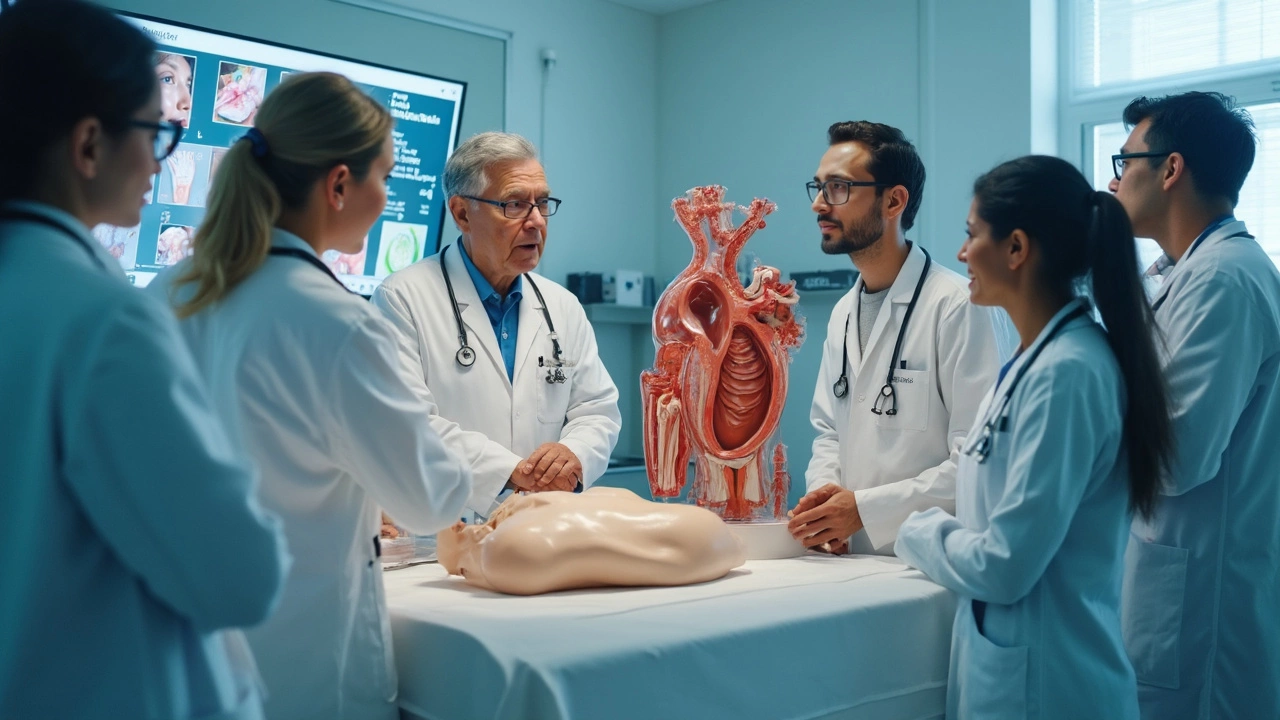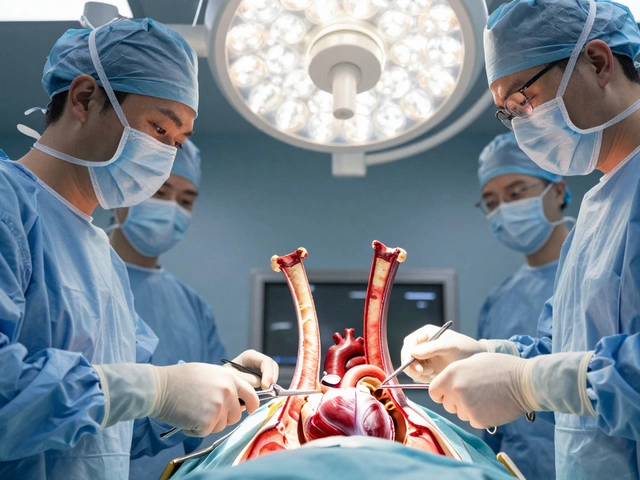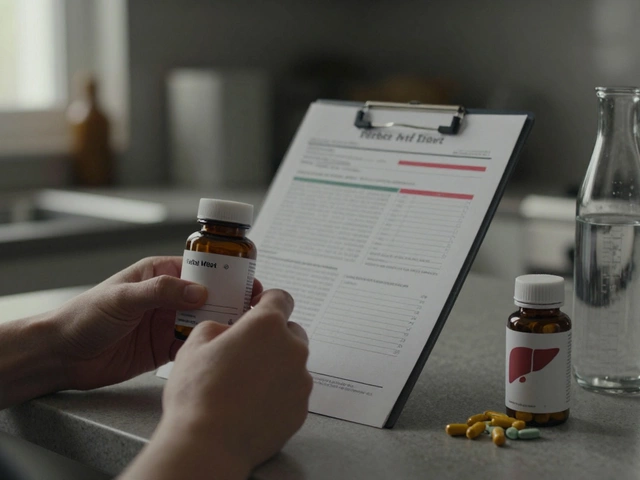- Home
- Cardiology
- Breasts and Open Heart Surgery: What Really Happens in the OR

Breasts and Open Heart Surgery: What Really Happens in the OR
If you or someone close to you needs open heart surgery, it’s normal to wonder about every detail—especially what happens to the chest and breasts during the operation. Surgeons have to get to the heart through the chest, so breasts are definitely part of the equation, whether you have a full chest or a more flat one.
Most people expect the obvious stuff: anesthesia, a big incision, lots of machines. But the way they handle breast tissue during the prep isn’t talked about much. It’s not just about cutting through; the team needs to make sure everything is out of the way, stays healthy, and heals as best as possible afterward.
Depending on your body shape, breast size, and even your age, the surgical approach can feel a little different. It’s usually not as dramatic as people fear, but if you’ve heard stories from friends or read some horror tales online—you’re not alone. The whole thing can sound intimidating. Here’s what you really need to know before rolling into that operating room.
- How Surgeons Prepare the Chest Area
- What Happens to Breast Tissue During Surgery
- Scarring and Breast Appearance After Surgery
- Tips for Comfort and Recovery
- What Your Doctor Might Not Tell You
How Surgeons Prepare the Chest Area
If you’re heading for open heart surgery, a lot of attention goes into setting up the chest area right before anyone touches the heart itself. First off, you’ll be fully asleep under anesthesia. The surgical team needs a wide, clear space, which means adjusting the position of your chest and, yep, your breasts.
The table is tilted to let gravity do some of the work, gently pulling breast tissue toward the sides. For people with larger breasts, the team may use special sticky drapes or soft foam pads to keep things in place and make sure nothing is compressed or pinched for hours. This helps keep blood flow steady so you don’t get pressure sores or numb spots after waking up. If you have smaller breasts, less handling is needed, but the same care is given so tissue isn’t in the way or gets damaged.
Here’s a quick rundown of what usually happens step-by-step:
- The skin over your chest is cleaned with a germ-killing solution to lower infection risks.
- Breasts are gently moved aside as needed (never roughly—they know what they’re doing).
- Sterile drapes go up, making sure both the chest and the breast edges stay covered and safe.
- Sometimes, foam or gel pads help support the breasts for extra comfort during the time you’re under.
In women, especially those with larger or heavier breasts, these extra steps are standard. They’re a team effort between the surgeon and nursing staff. In some hospitals, studies estimate about 20% of heart surgery patients are given extra padding or supports for their breasts, especially when surgery is expected to last longer than four hours.
None of this changes how the heart surgery is done, but it does affect how the whole chest—not just the breast tissue—feels during healing. Even if it sounds technical, the goal here is comfort and a quicker, smoother recovery.
What Happens to Breast Tissue During Surgery
The idea of your breasts being "moved" or messed with during open heart surgery sometimes worries people, especially women with larger chests. Here’s what actually goes down: before cutting, nurses and doctors make sure your breasts are positioned evenly on each side of your chest. They don’t remove them or cut through them. Instead, your breast tissue is gently shifted to the sides, kind of like tucking a shirt away so the middle—the chest bone—is exposed for surgery.
The main cut (called a median sternotomy) usually runs straight down the middle of your chest, so it passes between your breasts, not through them. If your breasts are large, the team may use special tape or foam pads to support them and keep them from shifting during the operation. This helps lower your risk of skin damage or irritation where your breasts rest against your chest for a long time.
For men, or anyone with a smaller chest, this isn’t a big deal because there’s less tissue in the way. For women with implants, the team takes extra care to avoid popping or damaging them, but heart surgeons are used to seeing all sorts of chest anatomy, so this is routine for them. The actual breast tissue doesn’t get cut or operated on. All the major action happens underneath or behind the breast, down at the breastbone and ribs.
One thing you can watch out for: sometimes, because of the way your chest and breasts are positioned during surgery, you might wake up with some swelling,, or even bruising on or under the breast area. This is usually temporary. If it sticks around or looks weird, talk to your surgical team right away. Here’s a quick rundown of what’s most likely to happen:
- Breast tissue is shifted aside, not removed or cut.
- Incision runs between the breasts, avoiding as much tissue as possible.
- Supports or pads are used for larger breasts to prevent pressure problems.
- Temporary swelling or bruising sometimes shows up post-surgery.
- Extra care is taken for people with breast implants.
Here’s an example of how common some issues are with breast care post-surgery:
| Issue | How Common |
|---|---|
| Swelling or bruising | About 15-20% of patients |
| Skin irritation or pressure | Roughly 10% (mainly large-breasted women) |
| Incision complications involving breast tissue | Rare (<3%) |
So, when you hear stories about weird things happening to people’s chests in the OR, know this: your breasts are in good hands. The focus is on protecting that tissue, not putting it at risk.

Scarring and Breast Appearance After Surgery
So, here's what usually happens: with open heart surgery, the main incision is made right down the middle of your chest, running from just below your neck to the bottom of your breastbone. For people with bigger breasts, that line usually cuts straight between the breasts, but doesn't slice through the actual breast tissue itself. It’s all about separating the muscle and bone under the skin, not the breast tissue.
This scar is called a median sternotomy scar. It can look pretty dramatic right after surgery—think red, swollen, and kind of bumpy. Don’t panic; this is normal. Over time, most scars fade a ton, but how much depends on your skin type, your age, genetics, and how you care for the scar afterward.
Here’s what folks tend to notice most after surgery:
- If you have fuller breasts, sometimes the scar tugs more on one side, especially when you move around. This can make the breasts look a little uneven at first.
- Women might see a dip or a groove right along the scar where the breast tissue parts to make room for the chest bone's healing. This groove may stick around for months.
- Nipples and breast shape don’t usually change, but some swelling or bruising can happen right after surgery. That’s temporary.
Serious problems like loss of nipple sensation or major changes in breast size are rare, though small changes in how things sit—especially if you have a larger chest—aren’t out of the question.
Some real numbers? According to a study published in 2023 from a major cardiac center, about 10% of women reported visible changes in the way their breasts sat or looked six months after open heart surgery. But only about 2% felt the changes were major enough to bother them day to day.
| Time After Surgery | Scar Appearance |
|---|---|
| 1 Month | Red, raised, possibly itchy |
| 3 Months | Paler, starting to flatten |
| 6 Months+ | Much lighter, less raised, but still visible |
Want to help your healing? Keep the incision clean, skip underwire bras at first, and ask your doc about scar creams or silicone strips. Some people swear by daily lotion and sunscreen once things have healed. No magic fixes, but these steps can definitely help keep things looking and feeling better as you get back to normal.
Tips for Comfort and Recovery
The days and weeks after open heart surgery can be rough, especially if you’re worried about how your breasts feel or look. Here’s some straight-up, practical advice to make recovery a little easier on your chest.
- Support matters: Right after surgery, wearing a loose or specially-designed surgical bra helps prevent strain on breast tissue and the incision. Medical teams usually recommend soft, front-closing bras—no underwire. Think comfort, not style.
- Watch out for swelling: Mild swelling around the chest and breasts is common. Ice packs (wrapped in a towel, of course) can help, but always check with your surgeon first to see what’s safe for you. Some people find that sleeping slightly propped up with extra pillows reduces swelling, too.
- Scarring is normal: Most people get a straight scar down the middle of their chest—called a median sternotomy scar. If your breasts are larger, the scar might curve a bit or look different depending on your natural fold. Keeping the incision clean and dry is the top priority for healing.
- Get moving (gently): Movement matters for recovery and for preventing shoulder or breast stiffness, especially after open heart surgery. Your doctor or physical therapist will probably show you some simple arm stretches you can do sitting down. Don’t push it—slow and steady wins here.
- Stay sun safe: If your scar is exposed, be careful in the sun for at least the first year. Scars darken fast in the sun, so cover up or use sunscreen if you’re out and about—even walking Bruno, my dog, counts.
Here’s a quick look at what to expect during those important first few weeks after surgery:
| Recovery Area | What to Expect |
|---|---|
| Breast Discomfort | Common for 2-6 weeks, easing up over time |
| Scar Appearance | Red and raised at first, fades slowly over months |
| Swelling | Normal, more if you have larger breasts |
| Support Bra | Usually worn about 6 weeks |
And don’t forget: If something feels off—like burning pain, redness, or unusual swelling—call your doctor. Trust your gut. It’s your body, and you should feel comfortable asking about anything, even if it seems minor. With the right care, your chest (and breasts) will heal up better than you expect.

What Your Doctor Might Not Tell You
There’s some stuff about breasts and open heart surgery you might not hear in the regular pre-surgery talk. First off, sometimes after surgery, your breasts can feel different—not just because of scars, but from swelling, numbness, or even weird sensations from nerve irritation. Your doctor may not mention that numb spots can last weeks or months and sometimes never totally go away.
If you have larger breasts, they can actually pull on the chest incision or make recovery a bit less comfortable, especially if you go braless at night. A lot of women figure this out only when they're sore and can't get comfy. Some people use a front-closure sports bra or even a surgical bra to help. And here’s a real tip: ask your surgeon or nurse about pillow placement—you can use a small pillow or rolled towel for support when resting or getting up.
There's also a small risk of something the doctors call “breast malposition” (basically, the breast shifting slightly after healing), but it’s rare unless you have implants or very large breasts. Surgeons aren’t always open about how common this is because it happens to a pretty small group, but it’s possible. Also, sometimes, breast tissue right in the middle of your chest—like right along the sternum—can heal a bit differently or look flatter. This is usually more noticeable in women with bigger breasts.
Don’t be surprised by how the scar might look at first—wide, red, or raised. It usually fades a lot after a year, but sometimes it can stay noticeable. Some folks use silicone sheets or vitamin E oil to help with healing, but the real secret is just patience. If your skin is prone to keloids (raised, bumpy scars), be sure to tell the team ahead of time.
- Ask for special pain relief pads or bandages if regular tape is uncomfortable (especially with body hair or sensitive skin around the chest and breasts).
- Plan for some changes in sensation and know they're usually temporary—talk to your doctors if it bugs you.
- If bruising shows up on the bottom or sides of your breasts, it's usually just blood settling and not a sign something went wrong.
Want numbers? About 20-30% of women report some numbness around the breast or sternum area after open heart surgery. But, and this matters, severe or long-term pain happens to less than 5% of folks. You’re much more likely to deal with mild soreness and weird tingling that improves over time.
| Symptom | How Common? |
|---|---|
| Numbness/tingling | Up to 30% |
| Swelling | About 10-15% |
| Long-term pain | 4-5% |
| Skin or shape changes | Less than 7% |
Doctors don’t always get into these details unless you ask. So don’t hesitate: bring up any questions about your breasts before surgery. Even if it feels awkward, it’s way better than guessing or worrying later.

Arnav Singh
I am a health expert with a focus on medicine-related topics in India. My work involves researching and writing articles that aim to inform and educate readers about health and wellness practices. I enjoy exploring the intersections of traditional and modern medicine and how they impact healthcare in the Indian context. Writing for various health magazines and platforms allows me to share my insights with a wider audience.
About
Medical Resource Center India is a comprehensive online platform dedicated to providing reliable health information and medical resources in India. Explore a wide range of articles, tips, and advice on medicine, healthcare services, and wellness. Stay informed about the latest developments in Indian medicine and access valuable insights into maintaining a healthy lifestyle. Discover expert guidance and health solutions tailored for every Indian citizen. Your go-to destination for authoritative medical knowledge in India.







